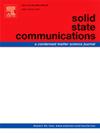Tunable electronic and optical properties of a Type-ⅡViolet Phosphorus/MoS2 heterojunction: First-principles calculation
IF 2.1
4区 物理与天体物理
Q3 PHYSICS, CONDENSED MATTER
引用次数: 0
Abstract
Photodetectors based on heterostructures have garnered significant research interest due to their superior self-powering and responsiveness capabilities. In this work, the optoelectronic properties of a violet phosphorus (VP/MoS2)/MoS2 heterojunction are investigated through first-principles calculations. The results reveal that the VP/MoS2 heterojunction possesses an indirect bandgap and a type-II band alignment. The interface potential drop (Ep) of the VP/MoS2 heterojunction is 5.45 eV by studying the interfacial interaction, suggesting the formation of a large in-built electric field and an excellent self-powering capability. The absorption coefficient of VP/MoS2 heterojunction are significantly higher in the UV and visible regions. Under biaxial strain, the VP/MoS2 heterostructure can undergo transformations from a semiconductor to a metal, from an indirect to a direct bandgap, and from a type-II to a type-I energy band structure. Moreover, the light trapping ability in the near-infrared region is significantly enhanced. These findings underscore the broader potential application of VP/MoS2 heterostructures in high-performance optoelectronic devices.
Ⅱ型紫磷/MoS2异质结的可调谐电子和光学特性:第一原理计算
基于异质结构的光电探测器因其卓越的自供电和响应能力而备受研究关注。本文通过第一原理计算研究了紫磷(VP/MoS2)/MoS2 异质结的光电特性。结果表明,紫磷/MoS2异质结具有间接带隙和II型带排列。通过研究界面相互作用,VP/MoS2 异质结的界面势降(Ep)为 5.45 eV,这表明该异质结形成了一个较大的内置电场,具有出色的自供电能力。VP/MoS2 异质结在紫外和可见光区域的吸收系数明显更高。在双轴应变作用下,VP/MoS2 异质结构可以实现从半导体到金属、从间接带隙到直接带隙、从 II 型能带结构到 I 型能带结构的转变。此外,近红外区域的光捕获能力也显著增强。这些发现强调了 VP/MoS2 异质结构在高性能光电器件中更广泛的应用潜力。
本文章由计算机程序翻译,如有差异,请以英文原文为准。
求助全文
约1分钟内获得全文
求助全文
来源期刊

Solid State Communications
物理-物理:凝聚态物理
CiteScore
3.40
自引率
4.80%
发文量
287
审稿时长
51 days
期刊介绍:
Solid State Communications is an international medium for the publication of short communications and original research articles on significant developments in condensed matter science, giving scientists immediate access to important, recently completed work. The journal publishes original experimental and theoretical research on the physical and chemical properties of solids and other condensed systems and also on their preparation. The submission of manuscripts reporting research on the basic physics of materials science and devices, as well as of state-of-the-art microstructures and nanostructures, is encouraged.
A coherent quantitative treatment emphasizing new physics is expected rather than a simple accumulation of experimental data. Consistent with these aims, the short communications should be kept concise and short, usually not longer than six printed pages. The number of figures and tables should also be kept to a minimum. Solid State Communications now also welcomes original research articles without length restrictions.
The Fast-Track section of Solid State Communications is the venue for very rapid publication of short communications on significant developments in condensed matter science. The goal is to offer the broad condensed matter community quick and immediate access to publish recently completed papers in research areas that are rapidly evolving and in which there are developments with great potential impact.
 求助内容:
求助内容: 应助结果提醒方式:
应助结果提醒方式:


